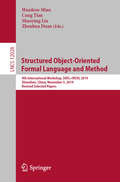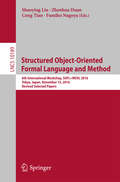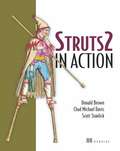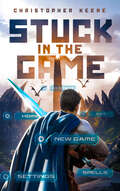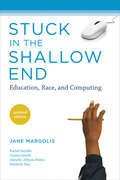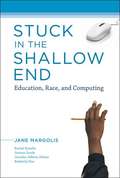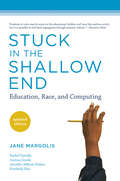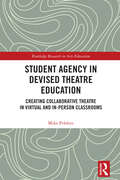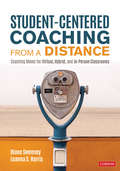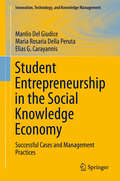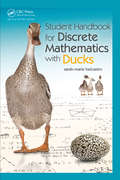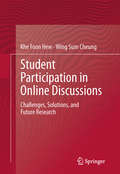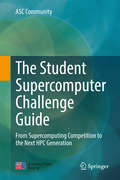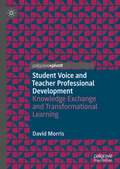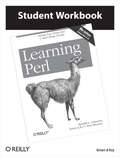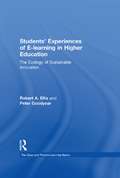- Table View
- List View
Structured Object-Oriented Formal Language and Method: 9th International Workshop, SOFL+MSVL 2019, Shenzhen, China, November 5, 2019, Revised Selected Papers (Lecture Notes in Computer Science #12028)
by Shaoying Liu Zhenhua Duan Cong Tian Huaikou MiaoThis book constitutes the thoroughly refereed workshop proceedings of the 9th International Workshop on Structured Object-Oriented Formal Language and Method, SOFL+MSVL 2019, held in Shenzhen, China, in November 2019. The 23 revised full papers included in the volume were carefully reviewed and selected from 43 submissions. They are organized in the following topical sections: testing and debugging, formal verification, problem solving, software analysis and evolution, and software analysis and testing.
Structured Object-Oriented Formal Language and Method
by Shaoying Liu Zhenhua Duan Cong Tian Fumiko NagoyaThis book constitutes the thoroughly refereed post-workshop proceedings of the 5th International Workshop on Structured Object-Oriented Formal Language and Method, SOFL+MSVL 2015, held in Paris, France, in November 2015. The 15 papers presented in this volume were carefully reviewed and selected from 22 submissions. The focus of this workshops was on following subjects: Modeling, specification, verification, model checking, testing, debugging, transformation, and algorithm.
Structured Object-Oriented Formal Language and Method: 10th International Workshop, SOFL+MSVL 2020, Singapore, March 1, 2021, Revised Selected Papers (Lecture Notes in Computer Science #12723)
by Jinyun Xue Fumiko Nagoya Shaoying Liu Zhenhua DuanThis book constitutes the refereed workshop proceedings of the 10th International Workshop on Structured Object-Oriented Formal Language and Method, SOFL+MSVL 2020, held in Singapore, in March 2021. The 13 revised full papers included in the volume were carefully reviewed and selected from 24 submissions. They are organized in the following topical sections: modeling and specification; model checking; specification and verification; and testing and formal verification.Due to the Corona pandemic this event was held virtually.
Structured Peer-to-Peer Systems
by Dmitry Korzun Andrei GurtovThe field of structured P2P systems has seen fast growth upon the introduction of Distributed Hash Tables (DHTs) in the early 2000s. The first proposals, including Chord, Pastry, Tapestry, were gradually improved to cope with scalability, locality and security issues. By utilizing the processing and bandwidth resources of end users, the P2P approach enables high performance of data distribution which is hard to achieve with traditional client-server architectures. The P2P computing community is also being actively utilized for software updates to the Internet, P2PSIP VoIP, video-on-demand, and distributed backups. The recent introduction of the identifier-locator split proposal for future Internet architectures poses another important application for DHTs, namely mapping between host permanent identity and changing IP address. The growing complexity and scale of modern P2P systems requires the introduction of hierarchy and intelligence in routing of requests. Structured Peer-to-Peer Systems covers fundamental issues in organization, optimization, and tradeoffs of present large-scale structured P2P systems, as well as, provides principles, analytical models, and simulation methods applicable in designing future systems. Part I presents the state-of-the-art of structured P2P systems, popular DHT topologies and protocols, and the design challenges for efficient P2P network topology organization, routing, scalability, and security. Part II shows that local strategies with limited knowledge per peer provide the highest scalability level subject to reasonable performance and security constraints. Although the strategies are local, their efficiency is due to elements of hierarchical organization, which appear in many DHT designs that traditionally are considered as flat ones. Part III describes methods to gradually enhance the local view limit when a peer is capable to operate with larger knowledge, still partial, about the entire system. These methods were formed in the evolution of hierarchical organization from flat DHT networks to hierarchical DHT architectures, look-ahead routing, and topology-aware ranking. Part IV highlights some known P2P-based experimental systems and commercial applications in the modern Internet. The discussion clarifies the importance of P2P technology for building present and future Internet systems.
Struggling for One America: Trump vs. Hollywood: The Two White Houses
by Daphne Barak Erbil GunastiWhat happens when you speak with Hollywood stars and entertainers—half pro-Trump and half against—posting the question, &“Can we talk?&” Since the 2016 presidential campaigns, Conservatives, Liberals, Democrats, Republicans, Whites, and non-Whites in America began saying loudly that they are &“Fighting for America.&” Yet, by the 2020 presidential elections, they were even more divided than united despite all the good intention of the most. Now that America is well into 2021, it is time to yearn for &“One America&” but without &“fighting.&” But here is the caveat! To achieve &“One America,&” the &“Trump Phenomena&” must first be understood. Next, &“Discrimination&” and &“Racism&” in America must be re-visited. After that, &“Cancel Culture&” and &“No-No Rhetoric&” must be handled promptly and sensitively. Finally, Hollywood must first embrace #MeToo Movement and then come up with a long-term strategy. Filmmakers of the Trump vs. Hollywood documentary, Daphne Barak and Erbil Gunasti brought on board twenty-four Hollywood stars and entertainers in a documentary to discuss these topics. Half were chosen among pro-Trump, and half against. Daphne interviewed both sides, posing the question: &“Can We Talk?&”Struggling For One America stands as the genesis of this documentary. This book in that respect points at the presumptive and pretended &“Culprits&” and &“Scapegoats&” in the current divide, while focusing on what is obvious. The two White Houses are standing tall, in plain sight, and a step further on the wrong direction from this moment on would be nothing less than repeating history.
Struktur und Design responsiver Webseiten auf Smartphones: Wie Sie das mobile Internet userfreundlich gestalten (essentials)
by Annika BrinkmannAnnika Brinkmann zeigt in diesem essential, wie mit wenigen Kniffen aus schlechten Beispielen gute mobile Webseiten entstehen können. Die Autorin erläutert, was getan werden muss, um Inhalte nicht zu klein oder zu groß für den verfügbaren Platz darzustellen, Navigationen sinnvoll zu strukturieren und von der richtigen Seite her einzublenden. Kurzum: Sie zeigt, wie man mobile Websites übersichtlich gestaltet, damit diese keinen User-Frust auslösen. Das mobile Internet hat die Nutzung von Webseiten auf Desktop-Computern längst hinter sich gelassen. „Mobile first“ ist angesagt, die Zeichen stehen oftmals sogar auf „Mobile only“-Nutzung des Internets – zumindest im Privatgebrauch.
Struts 2 in Action
by Andrew Psaltis Chad Michael DavisThe original Struts project revolutionized Java web development and its rapid adoption resulted in the thousands of Struts-based applications deployed worldwide. Keeping pace with new ideas and trends, Apache Struts 2 has emerged as the product of a merger between the Apache Struts and OpenSymphony WebWork projects, united in their goal to develop an easy-to-use yet feature-rich framework. Struts 2 represents a revolution in design and ease of use when compared to classic Struts. It adds exciting and powerful features such as a plugin framework, JavaServer Faces integration, and XML-free configuration.Struts 2 In Action introduces the Apache Struts 2 web application framework and shows you how to quickly develop professional, production-ready modern web applications. Written by Don Brown, one of the leading developers of Struts 2, Chad Davis, a passionate Struts 2 developer, along with Scott Stanlick, this book gently walks you through the key features of Struts 2 in example-driven, easy-to-digest sections.Struts 2 in Action delivers accurate, seasoned information that can immediately be put to work. This book is designed for working Java web developers-especially those with some background in Struts 1 or WebWork. The core content, covering key framework components such as Actions, Results, and Interceptors, includes new features like the annotation-based configuration options. You'll find chapters on Struts 2 plugins, FreeMarker, and migration from Struts 1 and WebWork 2. Finally, new topics such as the Ajax tags, Spring Framework integration, and configuration by convention give familiar subjects new depth. Purchase of the print book comes with an offer of a free PDF, ePub, and Kindle eBook from Manning. Also available is all code from the book.
Stuck in the Game
by Christopher KeeneNoah promised himself he would never play the world&’s most popular MMORPG—the Dream State. He&’d already lost too many friends to the addictive virtual world. But after a devastating car crash leaves Noah paralyzed, he&’s forced inside the game. The Dream State not only provides a connection with the outside world but also keeps his brain awake long enough for his body to heal. Dying in the game, however, could send Noah into a coma forever. To stay safe, he must remain in the lower levels, far away from the most dangerous monsters and players. Meanwhile, doctors grow concerned when Noah&’s girlfriend, Sue—who also sustained serious injuries in the crash—seemingly fails to connect to the game. When a mysterious avatar suggests to Noah that the last remnants of Sue&’s consciousness are being held prisoner in the highest level, Noah decides to risk everything to save her. Leaving the safety of the lower levels, Noah rises through the ranks and enters the most dangerous part of the game, allying with high-level players and unearthing clues to a sinister plot along the way. Now top players from across the world are hunting him. With his life on the line, can Noah save Sue and uncover the mystery?
Stuck in the Shallow End
by Jane MargolisThe number of African Americans and Latino/as receiving undergraduate and advanced degrees in computer science is disproportionately low, according to recent surveys. And relatively few African American and Latino/a high school students receive the kind of institutional encouragement, educational opportunities, and preparation needed for them to choose computer science as a field of study and profession. In Stuck in the Shallow End,Jane Margolis looks at the daily experiences of students and teachers in three Los Angeles public high schools: an overcrowded urban high school, a math and science magnet school, and a well-funded school in an affluent neighborhood. She finds an insidious "virtual segregation" that maintains inequality. Two of the three schools studied offer only low-level, how-to (keyboarding, cutting and pasting) introductory computing classes. The third and wealthiest school offers advanced courses, but very few students of color enroll in them. The race gap in computer science, Margolis finds, is one example of the way students of color are denied a wide range of occupational and educational futures. Margolis traces the interplay of school structures (such factors as course offerings and student-to-counselor ratios) and belief systems--including teachers' assumptions about their students and students' assumptions about themselves. Stuck in the Shallow Endis a story of how inequality is reproduced in America--and how students and teachers, given the necessary tools, can change the system.
Stuck in the Shallow End: Education, Race, and Computing (The\mit Press Ser.)
by Jane MargolisAn investigation into why so few African American and Latino high school students are studying computer science reveals the dynamics of inequality in American schools.The number of African Americans and Latino/as receiving undergraduate and advanced degrees in computer science is disproportionately low, according to recent surveys. And relatively few African American and Latino/a high school students receive the kind of institutional encouragement, educational opportunities, and preparation needed for them to choose computer science as a field of study and profession. In Stuck in the Shallow End, Jane Margolis looks at the daily experiences of students and teachers in three Los Angeles public high schools: an overcrowded urban high school, a math and science magnet school, and a well-funded school in an affluent neighborhood. She finds an insidious “virtual segregation” that maintains inequality. Two of the three schools studied offer only low-level, how-to (keyboarding, cutting and pasting) introductory computing classes. The third and wealthiest school offers advanced courses, but very few students of color enroll in them. The race gap in computer science, Margolis finds, is one example of the way students of color are denied a wide range of occupational and educational futures. Margolis traces the interplay of school structures (such factors as course offerings and student-to-counselor ratios) and belief systems—including teachers' assumptions about their students and students' assumptions about themselves. Stuck in the Shallow End is a story of how inequality is reproduced in America—and how students and teachers, given the necessary tools, can change the system.
Stuck in the Shallow End: Education, Race, and Computing
by Jane Margolis Jennifer Jellison Holme Joanna Goode Kim Nao Rachel EstrellaThe number of African Americans and Latino/as receiving undergraduate and advanced degrees in computer science is disproportionately low, according to recent surveys. And relatively few African American and Latino/a high school students receive the kind of institutional encouragement, educational opportunities, and preparation needed for them to choose computer science as a field of study and profession. In Stuck in the Shallow End, Jane Margolis looks at the daily experiences of students and teachers in three Los Angeles public high schools: an overcrowded urban high school, a math and science magnet school, and a well-funded school in an affluent neighborhood. She finds an insidious "virtual segregation" that maintains inequality. Two of the three schools studied offer only low-level, how-to (keyboarding, cutting and pasting) introductory computing classes. The third and wealthiest school offers advanced courses, but very few students of color enroll in them. The race gap in computer science, Margolis finds, is one example of the way students of color are denied a wide range of occupational and educational futures. Margolis traces the interplay of school structures (such factors as course offerings and student-to-counselor ratios) and belief systems -- including teachers' assumptions about their students and students' assumptions about themselves. Stuck in the Shallow End is a story of how inequality is reproduced in America -- and how students and teachers, given the necessary tools, can change the system.
Stuck in the Shallow End, updated edition: Education, Race, and Computing
by Jane MargolisWhy so few African American and Latino/a students study computer science: updated edition of a book that reveals the dynamics of inequality in American schools.The number of African Americans and Latino/as receiving undergraduate and advanced degrees in computer science is disproportionately low. And relatively few African American and Latino/a high school students receive the kind of institutional encouragement, educational opportunities, and preparation needed for them to choose computer science as a field of study and profession. In Stuck in the Shallow End, Jane Margolis and coauthors look at the daily experiences of students and teachers in three Los Angeles public high schools: an overcrowded urban high school, a math and science magnet school, and a well-funded school in an affluent neighborhood. They find an insidious “virtual segregation” that maintains inequality. The race gap in computer science, Margolis discovers, is one example of the way students of color are denied a wide range of occupational and educational futures. Stuck in the Shallow End is a story of how inequality is reproduced in America—and how students and teachers, given the necessary tools, can change the system. Since the 2008 publication of Stuck in the Shallow End, the book has found an eager audience among teachers, school administrators, and academics. This updated edition offers a new preface detailing the progress in making computer science accessible to all, a new postscript, and discussion questions (coauthored by Jane Margolis and Joanna Goode).
Student Agency in Devised Theatre Education: Creating Collaborative Theatre in Virtual and In-Person Classrooms (Routledge Research in Arts Education)
by Mike PobleteThis monograph argues that implementing devised theatre as a learning praxis has a unique potential to cultivate student agency in the twenty-first century classroom. It offers actionable guidance for drama instructors by providing a new arts education methodology that emphasizes the role of student-led dramaturgy. Based on quantitative and qualitative analyses of survey results, group interviews, and field observations from the facilitation of two original pieces of digital devised theatre created by Pacific Islander and Asian-American public high school students on Oʻahu, the author documents the crucial roles of constructive and resisting student agency in a devised theatre classroom. This book then departs from established research in suggesting that passivity serves a crucial role in allowing students to assert agency nonconfrontationally, which has considerable implications for peripatetic learners. It also investigates the role of student agency in online theatre education, which, along with expected challenges, was found to produce unique benefits, such as real-time documented performance feedback and accessible asynchronous teacher guidance. Further, a new form of student agency is identified, one exclusive to online learning environments, where students assert themselves by discussing technological challenges such as slow Wi-Fi, camera malfunctions, or other pragmatic concerns. Finally, this book makes a case that the success of these projects with Pacific Islander and Asian-American students suggests that although devising comes from a White Eurocentric tradition, it can provide an effective learning strategy for students from a wide variety of backgrounds.As global discourse continues to push toward reform that would allow populations around the world increased agency over their lives, this volume makes a unique contribution to the critical conversation around student agency in education today and will appeal to scholars and researchers across arts education, and theatre and performance studies.
Student-Centered Coaching From a Distance: Coaching Moves for Virtual, Hybrid, and In-Person Classrooms
by Diane Sweeney Leanna S. HarrisIdeas, inspiration, and the ‘moves’ to keep student learning at the center of instructional coaching--no matter where it occurs As we return to ‘normal’ the guidance in this book will ensure we continue to focus on deeply knowing our students, having a coherent and focused curriculum, and coaching from a place of formative assessment and evidence. Authors Diane Sweeney and Leanna Harris, whose best-selling books have influenced thousands of K-12 coaches, have written Student-Centered Coaching from a Distance to help coaches and teachers adapt. Each chapter includes coaching ‘moves’ that can be used in virtual, hybrid, and in person settings. These technology-focused moves are accompanied by language stems, note catchers, and other tools that provide structure and coherence to coaching conversations. Each chapter also provides specific moves that promote equity and work to remove many of the barriers that have been brought into clearer focus during the challenges of our times. Readers will find: • a highly effective coaching approach tailored to the distance learning context • strategies to help close opportunity gaps • in-depth instruction for co-teaching from a distance The enduring practices in this book will help coaches partner with teachers during challenging times and keep student learning at the center--for years to come.
Student-Centered Coaching From a Distance: Coaching Moves for Virtual, Hybrid, and In-Person Classrooms
by Diane Sweeney Leanna S. HarrisIdeas, inspiration, and the ‘moves’ to keep student learning at the center of instructional coaching--no matter where it occurs As we return to ‘normal’ the guidance in this book will ensure we continue to focus on deeply knowing our students, having a coherent and focused curriculum, and coaching from a place of formative assessment and evidence. Authors Diane Sweeney and Leanna Harris, whose best-selling books have influenced thousands of K-12 coaches, have written Student-Centered Coaching from a Distance to help coaches and teachers adapt. Each chapter includes coaching ‘moves’ that can be used in virtual, hybrid, and in person settings. These technology-focused moves are accompanied by language stems, note catchers, and other tools that provide structure and coherence to coaching conversations. Each chapter also provides specific moves that promote equity and work to remove many of the barriers that have been brought into clearer focus during the challenges of our times. Readers will find: • a highly effective coaching approach tailored to the distance learning context • strategies to help close opportunity gaps • in-depth instruction for co-teaching from a distance The enduring practices in this book will help coaches partner with teachers during challenging times and keep student learning at the center--for years to come.
Student Engagement in Campus-Based and Online Education: University Connections
by Hamish CoatesBlended learning is firmly established in universities around the world, yet to date little attention has been paid to how students are enaging with this style of learning. Presenting a theoretically-based and empirically-validated model of engagement, this book examines the application of the model to improve the quality and productivity of university education. Covering the key qualities of blended learning, it analyses how online learning influences campus-based education, develops the student perspective of online learning, examines online learning systems as agents of change, provides insights and guidance for educational developers and administrators attempting to improve quality of learning, and considers how institutions can maximise educational returns from large investments in online learning technologies. Illustrated with case studies and developing ideas for practice, this book will be valuable reading for researchers and developers keen to improve their understanding of the emerging dynamics of contemporary student engagement with online learning.
Student Engagement in the Digital University: Sociomaterial Assemblages
by Martin Oliver Lesley GourlayStudent Engagement in the Digital University challenges mainstream conceptions and assumptions about students’ engagement with digital resources in Higher Education. While engagement in online learning environments is often reduced to sets of transferable skills or typological categories, the authors propose that these experiences must be understood as embodied, socially situated, and taking place in complex networks of human and nonhuman actors. Using empirical data from a JISC-funded project on digital literacies, this book performs a sociomaterial analysis of student–technology interactions, complicating the optimistic and utopian narratives surrounding technology and education today and positing far-reaching implications for research, policy and practice.
Student Entrepreneurship in the Social Knowledge Economy
by Manlio Del Giudice Maria Rosaria Della Peruta Elias G. CarayannisTraditionally, the study of entrepreneurial behavior focuses on such factors as (i) the personality characteristics that distinguish the entrepreneur from non-entrepreneur and (ii) demographic characteristics such gender, age, familiar antecedents and education. With particular respect to investigating the development, acquisition, and dissemination of entrepreneurial skills and behaviors, the authors focus on the university environment, as a locus of research and innovation, where students are exposed to a wide variety of influences that are enhanced by a high degree of connectivity. The underlying theme of this volume is to develop our understanding of the sociology of student entrepreneurial behavior and in doing so attempt to synthesize literature investigating individual talent with the literature on concurrent knowledge sourcing in the pursuit of entrepreneurial activities. Specifically, the authors investigate the degree to which access to diverse knowledge (in addition to such psychological characteristics and tolerance of ambiguity and risk taking) influences the nature and probability of entrepreneurial success. Moreover, they explore the role of social media and social networking in facilitating access to distributed and disparate information and knowledge Their research addresses such timely questions as: Where do entrepreneurial opportunities come from? How can higher education best stimulate the creation of firms emanating from young and smart minds in colleges and universities? What is the value of MOOCs for frequent, early, and "thick" communication among the various specialties needed to accomplish entrepreneurial projects? How do we know whether social media affect students' responses to new knowledge and new ideas? To what extent do educational practices affect racial and ethnic differences in student entrepreneurship? What is the role of the indigenous minority student entrepreneur in establishing high-technology firms? The result is a multi-dimensional approach that sheds light on the dynamics of education, knowledge creation, social networking, innovation and new business development.
Student Handbook for Discrete Mathematics with Ducks: SRRSLEH
by sarah-marie belcastroStudent Handbook for Discrete Mathematics with Ducks is a Student Reference, Review, Supplemental Learning, and Example Handbook (SRRSLEH) that mirrors the content of the author's popular textbook Discrete Mathematics with Ducks (DMwD). This handbook provides a review of key material, illustrative examples, and new problems with accompanying soluti
Student Participation in Online Discussions
by Khe Foon Hew Wing Sum CheungThe increasingly prevalent use of online- or blended-learning in schools universities has resulted in asynchronous online discussion forum becoming an increasingly common means to facilitate dialogue between instructors and students, as well as students and students beyond the boundaries of their physical classrooms. This proposed academic book contributes to the literature on asynchronous online discussions in the following three main ways: First, it reviews previous research studies in order to identify the factors leading to limited student contribution. Limited student contribution is defined as students making few or no postings, students exhibiting surface-level thinking or students demonstrating low-level knowledge construction in online discussions. It then identifies the various empirically-based guidelines to address the factors. Second, three potential guideline dilemmas that educators may encounter: (a) use of grades, (b) use of number of posting guideline, and (c) instructor-facilitation are introduced. These are guidelines where previous empirical research shows mixed results when they are implemented. Acknowledging the dilemmas is essential for educators and researchers to make informed decisions about the discussion guidelines they are considering implementing. Third, nine exploratory case studies related to student-facilitation and audio-based discussion are reported on and examined. Using students as facilitators may be an alternative solution to educators who wish to avoid the instructor-facilitation guideline dilemma. Using audio discussion would be useful for participants with poor typing skills or those who prefer talking to typing. The proposed book is distinctive in comparison to current competitor titles because all the findings and guidelines are empirically-based. Furthermore, the nine expanded case studies provided specifically address the issue of student/peer facilitation and audio-based discussion. Student/peer facilitation and audio discussion are two areas that hitherto received comparatively lesser attention compared to instructor facilitation and text-based discussion.
The Student Supercomputer Challenge Guide
by Asc CommunityThis guide provides a comprehensive overview of High Performance Computing (HPC) to equip students with a full skill set including cluster setup, network selection, and a background of supercomputing competitions. It covers the system, architecture, evaluating approaches, and other practical supercomputing techniques. As the world’s largest supercomputing hackathon, the ASC Student Supercomputer Challenge has attracted a growing number of new talent to supercomputing and has greatly promoted communications in the global HPC community. Enclosed in this book, readers will also find how to analyze and optimize supercomputing systems and applications in real science and engineering cases.
Student Voice and Teacher Professional Development: Knowledge Exchange and Transformational Learning
by David MorrisThis book explores the role of students’ involvement in teacher professional development. Building upon a research study whereby pupils instruct their teachers in the use of Information and Communication Technology (ICT), the author argues that using student voice in this way can result in transformational learning for all those involved. The author presents the processes and experiences of pupils taking on the role of educators as well as the experiences of the teachers receiving such professional development from their students. In doing so, he promotes the innovative use of a student voice initiative to support teaching and learning, with the overarching purpose of improving and transforming teacher-pupil relationships. This book will be of interest and value to students and scholars of pupil voice, teacher professional development and transformational learning.
Student Workbook for Learning Perl
by Brian D FoyIf you’re a programmer, system administrator, or web hacker just getting started with Perl, this workbook helps you gain hands-on experience with the language right away.
Students' Experiences of e-Learning in Higher Education: The Ecology of Sustainable Innovation (Open and Flexible Learning Series)
by Robert Ellis Peter GoodyearStudents’ Experiences of e-learning in Higher Education helps higher education instructors and university managers understand how e-learning relates to, and can be integrated with, other student experiences of learning. Grounded in relevant international research, the book is distinctive in that it foregrounds students’ experiences of learning, emphasizing the importance of how students interpret the challenges set before them, along with their conceptions of learning and their approaches to learning. The way students interpret task requirements greatly affects learning outcomes, and those interpretations are in turn influenced by how students read the larger environment in which they study. The authors argue that a systemic understanding is necessary for the effective design and management of modern learning environments, whether lectures, seminars, laboratories or private study. This ecological understanding must also acknowledge, though, the agency of learners as active interpreters of their environment and its culture, values and challenges. Students’ Experiences of e-learning in Higher Education reports research outcomes that locate e-learning within the broader ecology of higher education and: Offers a holistic treatment of e-learning in higher education, reflecting the need for integrating e-learning and other aspects of the student learning experience Reports research on students’ experiences with e-learning conducted by authors in the United States, Europe, and Australia Synthesizes key themes in recent international research and summarizes their implications for teachers and managers.
A Student's Guide to Coding and Information Theory
by Stefan M. Moser Po-ning ChenThis easy-to-read guide provides a concise introduction to the engineering background of modern communication systems, from mobile phones to data compression and storage. Background mathematics and specific engineering techniques are kept to a minimum so that only a basic knowledge of high-school mathematics is needed to understand the material covered. The authors begin with many practical applications in coding, including the repetition code, the Hamming code and the Huffman code. They then explain the corresponding information theory, from entropy and mutual information to channel capacity and the information transmission theorem. Finally, they provide insights into the connections between coding theory and other fields. Many worked examples are given throughout the book, using practical applications to illustrate theoretical definitions. Exercises are also included, enabling readers to double-check what they have learned and gain glimpses into more advanced topics, making this perfect for anyone who needs a quick introduction to the subject.
